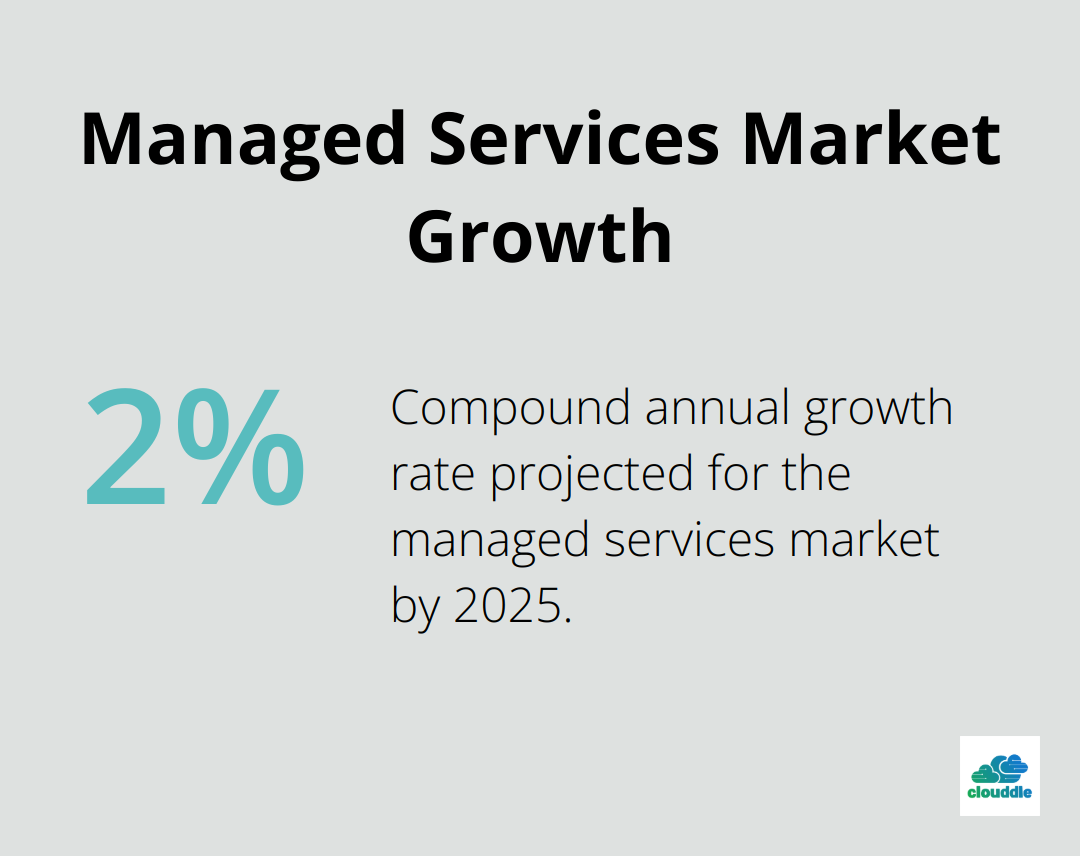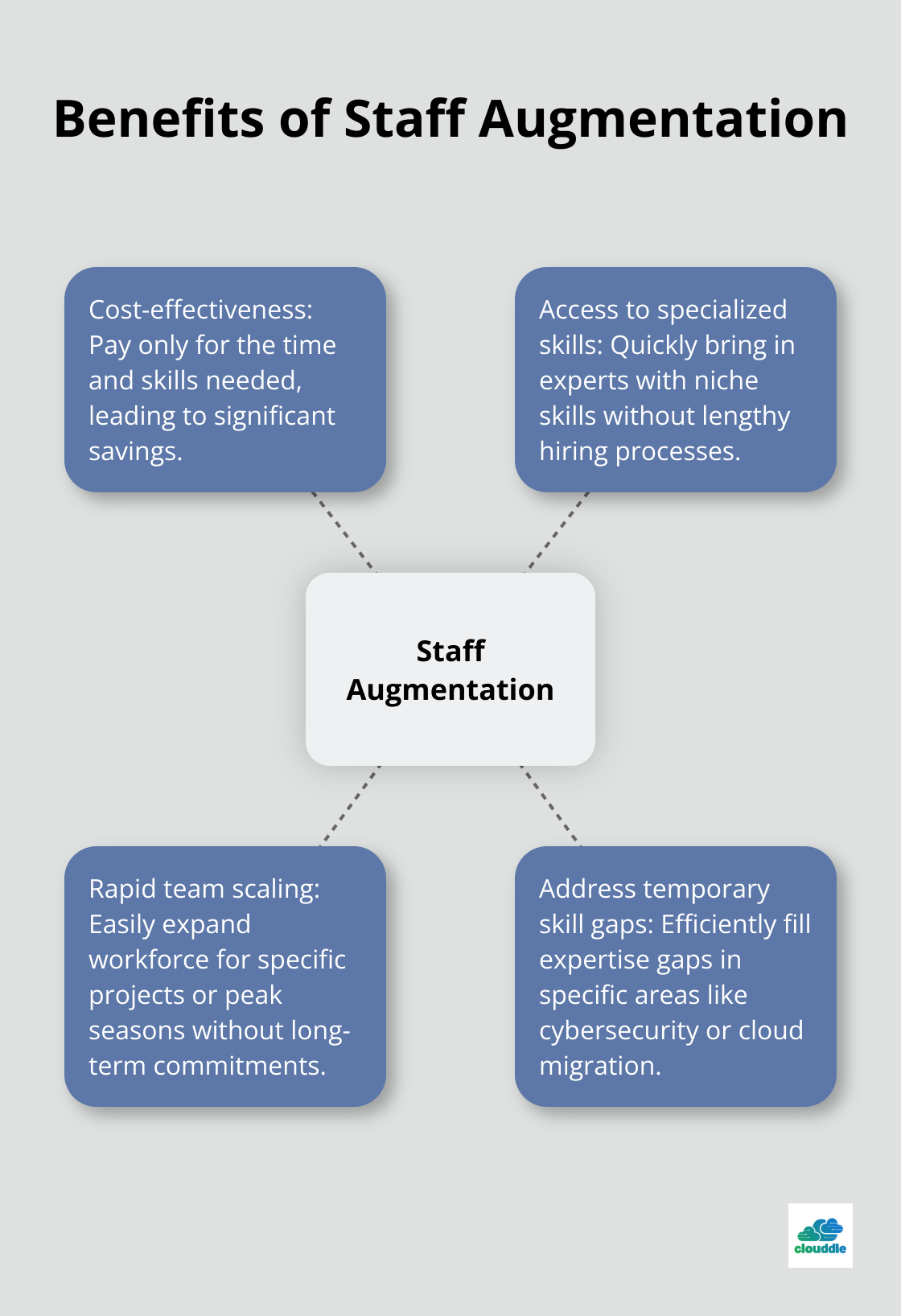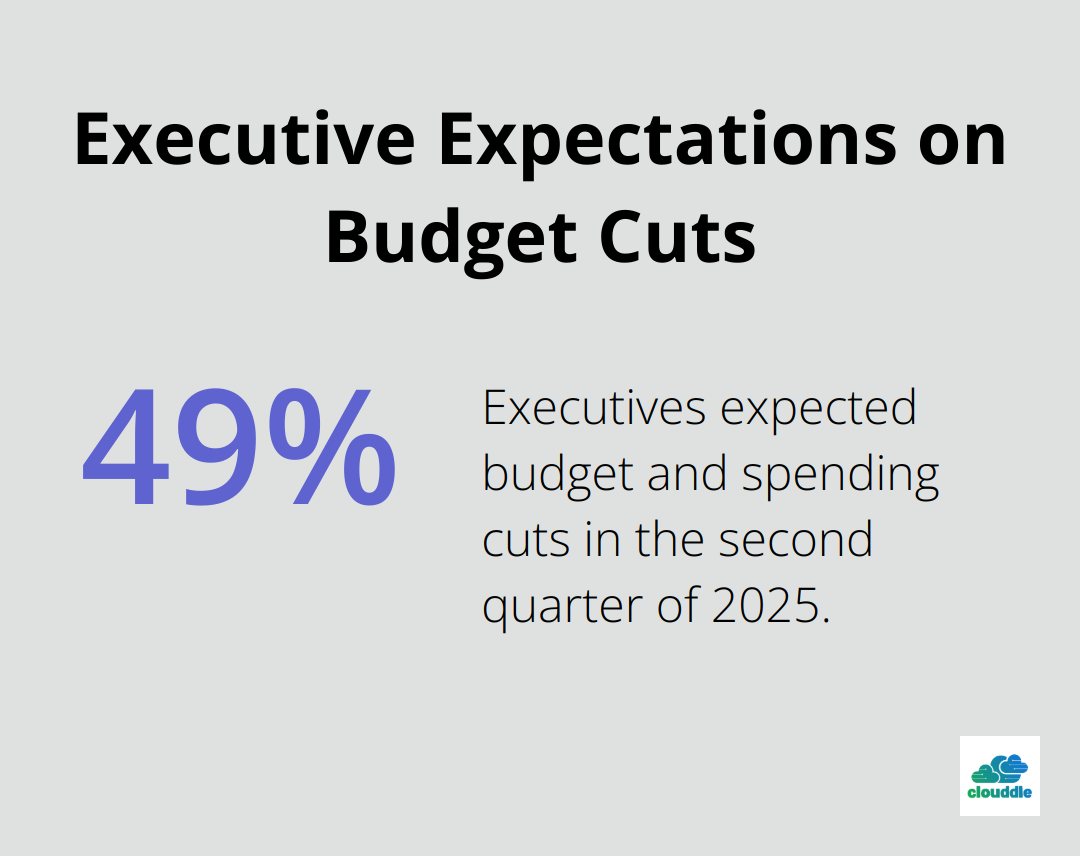At Clouddle, we often encounter businesses grappling with a crucial IT decision: choosing between managed services and staff augmentation.
This choice can significantly impact an organization’s efficiency, costs, and overall IT strategy.
In this post, we’ll explore IT managed services vs staff augmentation, highlighting the key differences and benefits of each approach.
We’ll provide you with the insights needed to make an informed decision that aligns with your business goals and needs.
What Are IT Managed Services?
IT managed services represent a comprehensive approach to outsourcing an organization’s IT operations. These services cover a wide range of IT functions, including network management, cybersecurity, cloud services, and help desk support. The managed services market shows significant growth potential, with Statista projecting it to reach $25.67 billion by 2025 (with a compound annual growth rate of 2.33%).
This growth indicates an increasing reliance on external expertise to handle complex IT environments.

In the hospitality industry, for example, managed services can encompass everything from guest Wi-Fi to back-office systems, allowing hotel staff to prioritize guest experiences over IT issues.
Key Benefits of Managed Services
Cost efficiency stands out as a primary advantage of managed services. Gartner reports that organizations can cut spending on software by as much as 30 percent by implementing three software license optimization best practices. This reduction stems from predictable monthly fees, the elimination of in-house IT staff needs, and decreased downtime.
Proactive monitoring represents another critical benefit. Advanced tools enable the detection and resolution of issues before they impact business operations. This proactive approach can lead to impressive uptime rates (often 99.9% or higher) for clients in sectors like multi-family dwelling, ensuring residents maintain constant access to critical services.
Common Managed Services
Network management forms a core offering in most managed service packages. This service includes monitoring network performance, managing firewalls, and ensuring optimal connectivity. For senior living facilities, robust networks can support everything from medical alert systems to resident entertainment services.
Cybersecurity has become an increasingly critical service. With rapidly evolving cyber threats, managed service providers offer up-to-date protection. IBM’s Cost of a Data Breach Report indicates that the average cost of a data breach in 2023 reached $4.45 million, underscoring the importance of robust security measures.
Cloud services management has grown in importance as businesses transition their operations to the cloud. This service includes cloud migration, optimization, and ongoing management. Many hospitality chains have benefited from transitioning to cloud-based property management systems, resulting in improved efficiency and guest satisfaction.
Help desk support remains a vital component of managed services. A 24/7 support team can resolve issues quickly, minimizing disruptions to business operations. Quick response times (ideally under 15 minutes) ensure that IT problems receive prompt attention.
As we explore the benefits of managed services, it’s important to consider how they compare to other IT solutions. In the next section, we’ll examine staff augmentation as an alternative approach to meeting IT needs.
Staff Augmentation: A Flexible IT Resourcing Strategy
Staff augmentation is a dynamic approach to IT resourcing that allows businesses to expand their workforce temporarily with specialized skills. This strategy addresses specific project needs or skill gaps without the long-term commitment of hiring full-time employees.
The Mechanics of Staff Augmentation
IT staff augmentation is a strategic outsourcing model that allows organizations to hire external IT professionals who can supplement their existing workforce. These professionals, typically hired through specialized agencies or platforms, can be onboarded quickly to meet immediate needs. The staff augmentation market’s value reached $299.3 billion in 2023, with a projected market size of approximately $857.2 billion in the future. This growth underscores the increasing popularity of this flexible staffing model.

Benefits of Staff Augmentation
Cost-Effectiveness
One of the primary advantages of staff augmentation is its cost-effectiveness. Companies only pay for the time and skills they need, which can lead to significant savings (especially for short-term projects or when dealing with fluctuating workloads). A Deloitte study found that 45% of financial companies in the United States use IT staff augmentation services, highlighting its effectiveness in managing costs and resources.
Access to Specialized Skills
Staff augmentation allows companies to access specialized skills quickly. In the fast-paced IT world, where new technologies emerge rapidly, this model enables businesses to bring in experts with niche skills without lengthy hiring processes. This advantage proves particularly valuable when implementing new technologies or tackling complex projects that require specific expertise.
Ideal Scenarios for Staff Augmentation
Staff augmentation excels in scenarios that require rapid team scaling. For example, when launching a new product and needing additional developers for a few months, staff augmentation provides extra hands without long-term commitments. It also addresses temporary skill gaps effectively. If a team lacks expertise in a specific area (like cybersecurity or cloud migration), bringing in augmented staff can fill that gap efficiently.
Industries such as hospitality and senior living often benefit from staff augmentation during peak seasons or when implementing new technologies. A hotel chain might use staff augmentation to strengthen its IT team during a major system upgrade, ensuring minimal disruption to guest services.
While staff augmentation offers numerous benefits, it’s important to compare it with other options like managed services. The next section will provide a detailed comparison between staff augmentation and managed services, helping you make an informed decision for your business based on specific needs, project duration, and desired level of control over IT operations.
Managed Services vs Staff Augmentation: A Comprehensive Comparison
When businesses choose between managed services and staff augmentation, they must evaluate several factors to determine the best fit for their IT needs. This decision can significantly impact an organization’s efficiency and bottom line.
Cost Considerations
Cost often tops the list of concerns for businesses. Managed services typically operate on a fixed monthly fee structure, which can result in substantial savings. A March 2025 Gartner poll of 500+ executives revealed 49% expected their budgets and spending to face cuts in the second quarter. This predictable cost model facilitates easier budgeting and proves particularly beneficial for long-term projects or ongoing IT needs.

Staff augmentation offers more flexibility in terms of costs. Businesses pay only for the specific skills and time required, which can be more cost-effective for short-term projects or when handling fluctuating workloads. The global IT staff augmentation market is expected to reach $12.7 billion by 2026, indicating its cost-effectiveness for many organizations.
Control and Expertise Factors
Managed services provide access to a wide range of expertise. In the hospitality industry, for example, a managed service provider can offer specialized knowledge in areas like guest Wi-Fi systems, property management software, and cybersecurity. This comprehensive approach ensures coverage of all IT needs without the necessity to hire multiple in-house experts.
Staff augmentation allows for more direct control over projects and team integration. This model proves particularly useful when a company needs to maintain oversight of sensitive projects or when specific skills must complement an existing team. A senior living facility might use staff augmentation to bring in experts for implementing new medical alert systems while maintaining control over the project’s direction.
Scalability and Strategic Considerations
Both models offer scalability advantages, but they differ in application. Managed services excel in providing scalable solutions for long-term IT needs. They can easily adjust services as a business grows, ensuring consistent IT support without the need for constant restructuring of internal teams.
Staff augmentation shines in scenarios requiring rapid scaling for specific projects. It’s ideal for businesses that experience seasonal fluctuations or need to quickly ramp up for a major initiative. The flexibility of staff augmentation allows companies to adapt swiftly to changing market demands without long-term commitments.
Industry-Specific Applications
Different industries benefit from these models in unique ways. In the hospitality sector, managed services can handle everything from guest Wi-Fi to back-office systems, allowing hotel staff to focus on guest experiences. Staff augmentation, on the other hand, might be used to strengthen the IT team during a major system upgrade, ensuring minimal disruption to guest services.
For multi-family dwellings, managed services can provide consistent support for resident-facing technologies (such as smart home systems). Staff augmentation could be employed for short-term projects like implementing new security systems or upgrading community-wide Wi-Fi.
The choice between managed services and staff augmentation depends on specific business needs, project timelines, and long-term IT strategy. Managed services offer comprehensive, long-term solutions with predictable costs, while staff augmentation provides flexibility and specialized skills for short-term needs.
Final Thoughts
IT managed services vs staff augmentation presents a complex decision for businesses. Both approaches offer distinct advantages, with managed services providing comprehensive, long-term solutions and staff augmentation offering flexibility for specific projects. The choice depends on factors such as project timelines, budget constraints, and desired level of control.
Companies must align their IT strategy with overall business objectives to maximize success. Whether improving customer experience or increasing operational efficiency, the right IT approach can significantly impact outcomes. Many businesses find that a hybrid model, combining elements of both managed services and staff augmentation, provides an optimal solution.
At Clouddle, we understand the nuances of these IT strategies across various industries. Our technology solutions have helped clients transform their operations and focus on core business activities. We encourage businesses to carefully assess their needs and partner with experienced providers to create an IT strategy that meets current requirements and positions them for future growth.


